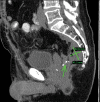Management of Acute Anastomotic Leaks
- PMID: 34853561
- PMCID: PMC8610640
- DOI: 10.1055/s-0041-1735271
Management of Acute Anastomotic Leaks
Abstract
Management of the acute anastomotic leak is complex and patient-specific. Clinically stable patients often benefit from a nonoperative approach utilizing antibiotics with or without percutaneous drainage. Clinically unstable patients or nonresponders to conservative management require operative intervention. Surgical management is dictated by the degree of contamination and inflammation but includes drainage with proximal diversion, anastomotic resection with end-stoma creation, or reanastomosis with proximal diversion. Newer therapies, including colorectal stenting, vacuum-assisted rectal drainage, and endoscopic clipping, have also been described.
Keywords: anastomotic leak; colorectal surgery; colostomy; endoscopy; ileostomy.
Thieme. All rights reserved.
Conflict of interest statement
Conflict of Interest None declared.
Figures




References
-
- Elagili F, Stocchi L, Ozuner G, Dietz D W, Kiran R P. Outcomes of percutaneous drainage without surgery for patients with diverticular abscess. Dis Colon Rectum. 2014;57(03):331–336. - PubMed
-
- Siewert B, Tye G, Kruskal J. Impact of CT-guided drainage in the treatment of diverticular abscesses: size matters. AJR Am J Roentgenol. 2006;186(03):680–686. - PubMed
-
- Reed T, Economon D, Wiersema-Bryant L.Colocutaneous fistula management in a dehisced wound: a case study Ostomy Wound Manage 2006520460–64., 66 - PubMed

